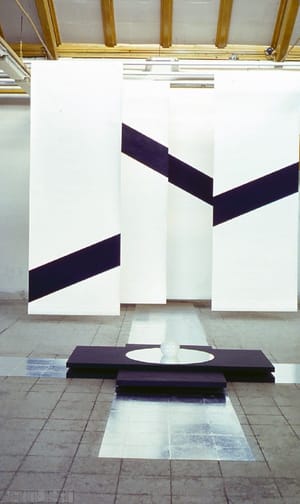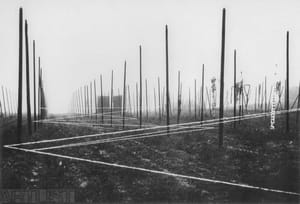- First Name
- Stanislav
- Surname
- Zippe
- Born
- 1943
- Birth place
- Hořice v Podkrkonoší
- Place of work
- Prague
- Website
- www.volny.cz/zippe
- Died
- 2024
- Keywords
- CSU Library
- ↳ Find in the catalogue
About artist
creator of lighted kinetic plastics and lighted space installations. He was born in 1943 in Hořice v Podkrkonoší, where he studied at the sculpture school (1957-1961). He ranks among the top Czech representatives of kinetic art. During the first half of the 1960s he created geometric abstract paintings that developed relationships between squares on a surface, creating the impression of a collapsing system (for example Structure/Struktura dating from 1962). In the 1960s he also created proposals for three monumental public plastic works: his model for the Agricultural College (Vysoká škola zemědělská) dated from 1965 (it was built a year later). In 1967 he took part in a competition for plastic works for the new court building in Ústí nad Labem.
His proposal for plastics for the telecommunications centre in Holečková Street in Smíchov already incorporated artificial light from reflectors hidden behind round, concave, bent surfaces, all meant to light up and turn off and thus create lighting effects on the plastics‘ surfaces. He gradually begins to move toward dematerialisation. He shifts from sculptural objects using natural light to the total denial of volume and shape. His approach is increasingly minimalist, focused on the actual visual experience stripped of its symbolic and narrative content.
Together with other members of the Syntéza (Synthesis) group he collaborated on scenography for theatrical performances; for example, for the ballet Spirála in 1968 at Prague’s Musical Theatre (Divadlo hudby), created in co-operation with Vladislav Čáp (light direction), Stanislav Zippe (hung object), Václav Kučera (composer) and František Pokorný (choreographer). Zippe’s object (with a size of 2x2 metres) consisted of wooden crates painted white. Its form changed during the course of the show. In the exhibition hall he showed a lighted kinetic plastic work, Transformation/Proměna, created from four white square surfaces placed on the ground and lit up by lamps. This was his first work to markedly thematise artificial light. The colour of the central light changed at regular intervals, while the remaining four light sources in the corners changed gradually and created a kinetic movement. The newly-created musical composition by Rudolf Komorous, Malevič’s Gravestone/Náhrobek Malevičův, accompanied the plastic piece.
Between 1967-69 his Luminospheric Variations/Luminosférické variace, were first shown in the Musical Theatre (Divadlo hudby). Pins with their heads coloured in fluorescent paint were poked in a black surface that featured a spiral, wire line leading from one corner of the frame to another. The wire aggressively moved into the surrounding space and came back again. He first used ultra-violet rays for lighting. Under the lighting the dark surface disappears and escapes the actual light action, restricted to focus on colour spots and lines. In 1969 Zippe created a model of an artificial universe together with Vladislav Čáp for the Paris Youth Biennale. It was a sort of utopian space stripped of gravitation. They placed diagonal glass surfaces covered with lenses into a glass box. The glass surfaces mirrored one another and moved leading to the relativisation of the space and creating a feeling of spatial confusion. In summer 1969 Zippe held his first independent exhibit, Kinetic Objects/Kinetické objekty, at the Charles Square Gallery. At this exhibit he showed his plastics, Transformation, Luminospheric Variations, and drawings of artificial universes, created by floating fluorescent paints on paper sprayed with black latex. In the installation, Spirála, he placed a black mirror lit up by a UV lamp into a dark corner of the room. He laid out several balls painted with fluorescent colours, and in the centre of the room he placed a lit up wire circle. A rotating spiral run by a motor hung from the ceiling, thus creating a dominant kinetic feature in the installation.
Roughly around 1973 darkened, concrete spaces lit with ultraviolet light having lit lines covered in luminescent colours and hung in the area in varied, often abruptly cut angles, begin to emerge. The visitor entering these installations‘ space – Zippe called them Light Constructions – finds him/herself in the dark and ceases to be aware of actual spatial borders, given that the only orientational points are the lit up lines. The spatial confusion is enhanced by the fact that the lines often do not begin in the corners or on the walls but rather in the centre of the space. This leads to the marked denial of spatial parameters in the original space and creates a new, virtual space. Zippe also created a number of proposals designated for open, outdoor spaces. In these cases laser rays created the lines (for example in his Lighted Lines for Zlín/Světelné linie pro Zlín project, 1994). At a symposium in Mutějovice (1983) he led criss-crossed lines through a hops field, creating one of few works perceivable in the light and from outside the space.
In the 1980s he experimented with computers and in the 1990s he devoted an increasing amount of time to work with electronic technologies. In this he drew upon the simplicity of his earlier works and continued to develop constructivist motifs. His projections set up in darkened spaces create an atmosphere, which is similarly absorbing to that in the early lighted space installations of Josef Hlaváček. Zippe’s approach is typically characterised as „IT (informatics) misused for imaginative purposes.“ The piece, RGB – Amorphous Structure/RGB – Amorfní struktura (2004), is a big-screen video projection created from an hour-long programme by the artist. It randomly generates freely-changing, coloured nebulae The computer installation, Unsettled Construction/Neklidné konstrukce (2004) consists of three of the artist’s programmes that together create one visual whole-triptych. Each programme sorts out the same problem, but each time in a different colour (red, green, blue). The common problem is the creation and following of units, similar to wire-made cubes, through which a special ever-changing image similar to a live organism is formed.
- Author of the annotation
- Lenka Dolanová
- Published
- 2005
CV
Exhibitions
- Solo exhibitions
-
2004
Stanislav Zippe, Galerie VŠUP
1996
Světelná pole, Galerie hlavního města Prahy, Staroměstská radnice, Praha
1994
Dům umění, Brno; Výstavní síň E. Filly, Ústí nad Labem
1993
České muzeum výtvarných umění (bývalá Středočeská galerie), Praha
1992
Galerie Delta, Frýdek-Místek
1991
Galerie Vincence Kramáře, Praha; Galerie U bílého jednorožce, Klatovy; Galerie studio Opatov, Praha
1988
Městské muzeum, Hořice v Podkrkonoší
1987
Galerie 55, Kladno
1978
Divadlo v Nerudooce, Praha
1969
Galerie na Karlově náměstí, Praha
- Group exhibitions not included in ARTLIST.
-
1994
Česká grafika šedesátých let, Národní galerie Praha; Český mimetismus 60. let, Galerie 60/70, Praha
1990
Výstava stipendisté, Lidový dům, Praha; se skupinou Tolerance, galerie Čs. Spisovatel, Praha; Jiná geometrie, Maďarské kulturní středisko
1989
Sochy a objekty v Národním technickém muzeu, Praha; Null-Dimension, Wroclaw, Polsko
1988
Pražský salon, PKOJF, Praha; Null-Dimension, Fulda; Geometrie v současném výtvarném umění, Litvínov
1983
„Chmelnice“ (symposium), Mutějovice
1969
Pražský salón, Praha; 7. bienále mladých, Paříž, Francie
1968
se skupinou Syntéza, Divadlo hudby, Praha
1966
se skupinou Syntéza, ÚLUV, Praha
Monography
- Monography
1999 SOCHA A OBJEKT IV., mezinárodní výstava, Bratislava, Slovensko; II. Nový zlínský salon, Státní galerie ve Zlíně, Dům umění, Zlín
1998 J. Hlaváček ÁJÁT, text v katalogu výstavy v galerii „Die Aktualität des schönen…“, Liberec
1996 K. Srp Světelná pole, text katalogu výstavy v GHMP v Praze
1995 Nová Encyklopedie českého výtvarného umění, Academie 1995, str. 955
1994 J. Machalický text v katalogu výstavy Grafika šedesátých let
1993 A. Potůčková text v katalogu samostatné výstavy v českém muzeu výtvarných umění v Praze
1991 A. Svoboda Stanislav Zippe instalace, projekty a obrazy, Ateliér 6/1991; J. Valoch text v katalogu samostatné výstavy v Galerii V. Kramáře; (JH) Zippe a světlo, Literární noviny 14/1991; A. Svoboda Stanislav Zippe Vztahové kresby, Ateliér 22/1991, str. 8
1990 M. Klivar Myslitel konstruktivního umění Stanislav Zippe, Architektura 3/1990; J. Hlaváček Text v katalogu výstavy Jiná geometrie
1989 A. Svoboda Světlo a geometrie Stanislava Zippeho, Panorama 4/1990
1988 J. Valoch: text v katalogu výstavy Geometrie v současném výtvarném umění, ZK Benar Litvínov; Jazyk geometrie v současném výtvarném umění, časopis Ateliér, č. 11, s.4; Současné umění v netradičním prostoru, Lidová demokracie 17.9. 1988; J. Hlaváček, text do katalogu samostatné výstavy v městském muzeu v Hořicích v Podkrkonoší; Igor Zhoř text do katalogu výstavy Možnosti vlákna, Galerie v předsálí, Blansko
1982 J. Valoch, text do připravovaného katalogu, neuskutečněno (rukopis)
1979 JAZZ 25 (Rozhovor s K. Srpem)
1978 katalog samostatné výstavy, divadlo v Nerudooce, Praha (rozhovor s R. Prahlem)
1970 Výtvarné umění, č. 7; Dušan Konečný Kinetismus, Palas Bratislava
1969 Katalog 7. bienále mladých v Paříži, Francie; Doba, č. 207
1968 Form, č.7, Anglie

